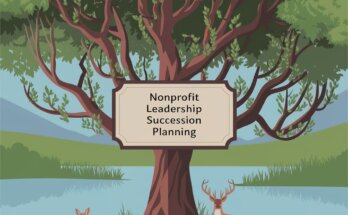Avoiding burnout as a nonprofit leader requires a proactive approach. Being a nonprofit leader is deeply rewarding, but it can also be extremely challenging.
Balancing the demands of managing a team, meeting funding goals, overseeing programs, and constantly seeking ways to expand the organization’s impact can easily lead to burnout.
Burnout affects your productivity, your passion, and ultimately, the mission you’re trying to fulfill. So, how do you keep burnout at bay and stay energized in this important work?
In this blog post, we’ll explore powerful strategies to help you avoid burnout and continue leading with enthusiasm and resilience.
What Is Burnout?
Before we get into strategies, let’s clarify what burnout actually means.
Burnout is not just feeling tired after a long day. It’s a state of emotional, mental, and physical exhaustion that happens when you’ve been under prolonged stress.
When you reach this point, work that once energized you feels like a heavy burden, and even small tasks can feel overwhelming.
Recognizing early signs like constant fatigue, irritability, and a loss of motivation is key to taking preventive action.
Strategy 1: Set Realistic Goals
It’s easy to fall into the trap of setting unrealistic goals for yourself and your organization. While aiming high is essential for growth, expecting to achieve the impossible is a recipe for burnout.
Setting attainable and measurable goals will keep you and your team motivated without the added stress of unmanageable expectations.
Practical Example: Let’s say your goal is to double donations in a year. Instead of pushing toward that single target, break it down. Aim to increase donations by 10% each quarter. This approach makes the goal more achievable and gives your team time to adjust and optimize your fundraising efforts.
Strategy 2: Build a Strong Support Network
In nonprofit work, it’s common to feel isolated, especially when challenges arise. A support network of like-minded leaders can provide invaluable encouragement, advice, and a listening ear.
Leaning on others who understand your unique struggles can be a significant relief and a great source of practical strategies.
Practical Example: Join local nonprofit groups or online forums where nonprofit leaders gather. Sharing your challenges and hearing others’ stories reminds you that you’re not alone in this journey. Consider reaching out to experienced leaders for mentorship, which can give you new insights and help you avoid common pitfalls.
Strategy 3: Prioritize Self-Care
One of the most powerful tools against burnout is self-care. It might sound simple, but setting aside time for yourself each day can make all the difference in how you handle stress.
Practical Example: Schedule short breaks throughout the day, even if it’s just five minutes to step outside or do some deep breathing exercises. You could also start each day with a personal routine—exercise, a good breakfast, or a few minutes of mindfulness. Building these habits gives you a foundation of strength and resilience.
Strategy 4: Delegate Responsibilities
A common trait among leaders, especially in nonprofits, is the “I-can-do-it-all” mindset. But this approach often leads to exhaustion. Delegating tasks is not only essential for your well-being but also empowers your team members, helping them grow and take on new responsibilities.
Practical Example: Identify tasks you can hand off. Maybe you’ve been handling social media, event planning, and donor communications yourself. Find capable team members or volunteers who can take these on, freeing up your time to focus on bigger-picture strategy and decision-making.
Strategy 5: Embrace Flexibility
In the nonprofit world, things rarely go as planned. Embracing flexibility helps you adapt to changes without feeling stressed or defeated. A flexible mindset allows you to pivot your strategies, work with available resources, and ultimately, handle setbacks with greater ease.
Practical Example: Suppose an event doesn’t raise as much money as you anticipated. Instead of seeing it as a failure, consider it a learning opportunity. Analyze what could have been done differently and apply those lessons to your next fundraiser. Keeping a flexible attitude reduces pressure and opens doors for improvement.
Strategy 6: Regularly Assess Your Workload
It’s crucial to periodically review your workload and responsibilities. If you’re constantly overwhelmed, it’s a sign you may need to reevaluate your priorities and tasks.
Practical Example: Every few weeks, sit down and write out all your responsibilities. Identify tasks that are most important to your organization’s mission and consider which ones could be postponed, simplified, or delegated. This regular “check-in” with yourself helps you stay focused on what truly matters.
Strategy 7: Foster a Positive Work Environment
A positive work environment is vital to prevent burnout, not only for you but for your team as well. When people feel supported, appreciated, and connected, they’re less likely to feel stressed.
Practical Example: Create a culture of recognition in your organization. Acknowledge your team’s achievements, big or small. For instance, after a successful event, host a team lunch to celebrate. When people feel valued, morale stays high, and burnout is less likely.
Strategy 8: Set Boundaries
It’s easy for work to spill over into your personal life, especially in a field driven by passion and purpose. Setting clear boundaries can help maintain a healthy work-life balance.
Practical Example: Decide on specific work hours and stick to them. Avoid checking emails or taking calls outside these hours. Clearly communicate these boundaries to your team and let them know you encourage the same balance for them. Boundaries help you recharge and maintain your effectiveness over the long haul.
Sarah’s Wake-Up Call
Let’s look at a real-life example.
Sarah was the executive director of a small nonprofit dedicated to animal welfare. Passionate about her mission, Sarah spent long hours organizing events, handling admin work, and even taking care of some rescued animals herself. She pushed herself hard because she believed it was the only way to make an impact.
One day, Sarah realized she was consistently exhausted, irritable, and her enthusiasm for the cause was fading. Her turning point came when she missed an important family event because she was preoccupied with a last-minute crisis at work. Realizing her personal life was suffering, she decided it was time to make changes.
Sarah started by setting boundaries and limiting her work hours. She trained her team members to take on responsibilities she’d been handling herself and adopted a routine that included daily self-care, like yoga and meditation.
With these adjustments, she regained her energy and passion for her work. Her nonprofit continued to grow, and her team felt more engaged and capable.
Sarah’s story shows that avoiding burnout is not just about self-care, but also about sustainable leadership practices.
Strategy 9: Invest in Professional Development
Professional development can help you build the skills needed to tackle challenges and prevent burnout. Expanding your expertise also keeps you excited about your work and gives you practical tools to overcome stress.
Practical Example: Attend workshops on nonprofit management, time management, or stress management. Networking events and training sessions expose you to new ideas, fresh approaches, and other nonprofit professionals who can share their experiences and advice.
Strategy 10: Practice Mindfulness
Mindfulness helps you stay focused, manage stress, and build resilience. It’s a powerful practice for managing the emotional demands of leadership.
Practical Example: Start your day with a few minutes of mindfulness meditation. This could involve sitting quietly, focusing on your breath, or simply noticing your thoughts without judgment. Practicing mindfulness regularly can help you stay calm, even during the busiest times.
Strategy 11: Keep Perspective on Your Mission
Sometimes, we get so wrapped up in day-to-day tasks that we lose sight of the larger mission. Regularly reconnecting with the purpose of your work can help you regain perspective and motivation.
Practical Example: Remind yourself and your team of the impact you’re creating. For example, if your organization supports youth development, invite young people who have benefited from your programs to share their stories. Hearing about the difference you’re making can rekindle your passion and help you push through tough times.
Strategy 12: Celebrate Small Wins
In nonprofit work, every bit of progress counts. Celebrating small wins can boost morale and give you and your team a sense of accomplishment.
Practical Example: Don’t wait for big milestones to celebrate. Acknowledge every step forward—whether it’s a new grant, a successful event, or positive feedback from the community. Celebrating these small victories helps you and your team stay motivated and focused on the positive aspects of the work.
Reclaim Your Energy and Passion
Avoiding burnout as a nonprofit leader is essential for your well-being and the success of your organization.
By implementing these strategies—setting realistic goals, building a support network, prioritizing self-care, and more—you can create a sustainable work environment that benefits both you and your team.
Remember, taking care of yourself is not just beneficial for you; it directly impacts the strength and success of your organization. When you’re energized and motivated, you can lead with vision and inspire others to join you in your mission.
Call to Action:
If you found these tips helpful and want more expert advice on navigating the nonprofit world, subscribe to the Nonprofit Navigators Newsletter!
Get access to job opportunities, grant opportunities, exclusive webinars, events, and other valuable resources tailored just for nonprofit professionals.
Join us and empower yourself with the tools to thrive in your leadership journey.
>>>>Additional Resources>>>>>
- The Small Business’s Guide to Winning Grants
- Request for Proposal Success: How to Write Proposals That Win
- The Ultimate Guide to Federal Grant Applications: Techniques for Success
- Digital Marketing for Nonprofits: A Comprehensive Guide to Boosting Your Impact Online
- Mastering Online Fundraising: A Nonprofit’s Guide to Digital Success




